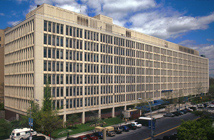University Hospital at Downstate

Our residents spend two half days per week in the adult ambulatory resident clinics at SUNY Downstate. Trainees see a wide variety of skin diseases and work directly with attendings to develop appropriate management plans. SUNY Downstate Health Sciences University also serves as one of our core sites for aesthetics training. Third year residents spend one afternoon clinic a week performing various procedures including chemical peels, sclerotherapy, neuromodulator and filler injections, electrosurgery, laser hair reduction, as well as pulse-dye laser and intense pulsed light treatments.
Residents work as a three-person team to manage the consultation services at the core campus hospitals, KCH and SUNY. The consult team functions with the goal of graduated responsibility throughout the three years of residency. First year residents learn the basics of consultative dermatology and perform most bedside procedures. The second year resident is given a greater degree of autonomy and is often the first to see consult patients, developing a differential diagnosis and treatment plan that they then present to the senior resident and attending. The third year resident is the consult senior and runs the service with the guidance of a seasoned attending.
- Adult outpatient clinic
- Cosmetic and laser clinic
- Phototherapy clinic
- Adult and pediatric inpatient, emergency department, and critical care consults
- Faculty practice pediatric clinic
Conditions often treated at SUNY Downstate include: connective tissue diseases, psoriasis, acne, keloids, alopecia, morbilliform drug eruptions, TEN, DRESS, HIV-related dermatoses, infantile hemangiomas, blistering diseases, vasculitides, hidradenitis suppurativa, syphilis, vitiligo, urticaria, melasma, human papillomavirus, eczema coxsackium, hand foot and mouth disease, bullous impetigo, bacterial/fungal/viral infections, atopic dermatitis, contact dermatitis, seborrheic dermatitis
Rare conditions also treated at SUNY Downstate include: scleromyxedema, ostraceous psoriasis, Kaposi's sarcoma, elephantiasis verrucosa nostra, pemphigus vulgaris, erythema nodosum, mixed connective tissue disease, Papillon-Lefevre syndrome, delusions of parasitosis, neurofibromatosis type 1, connective tissue nevi, dermatomyositis, mucucutaneous leishmaniasis, nephrogenic systemic fibrosis, eosinophic pustular folliculitis, pyoderma gangrenosum